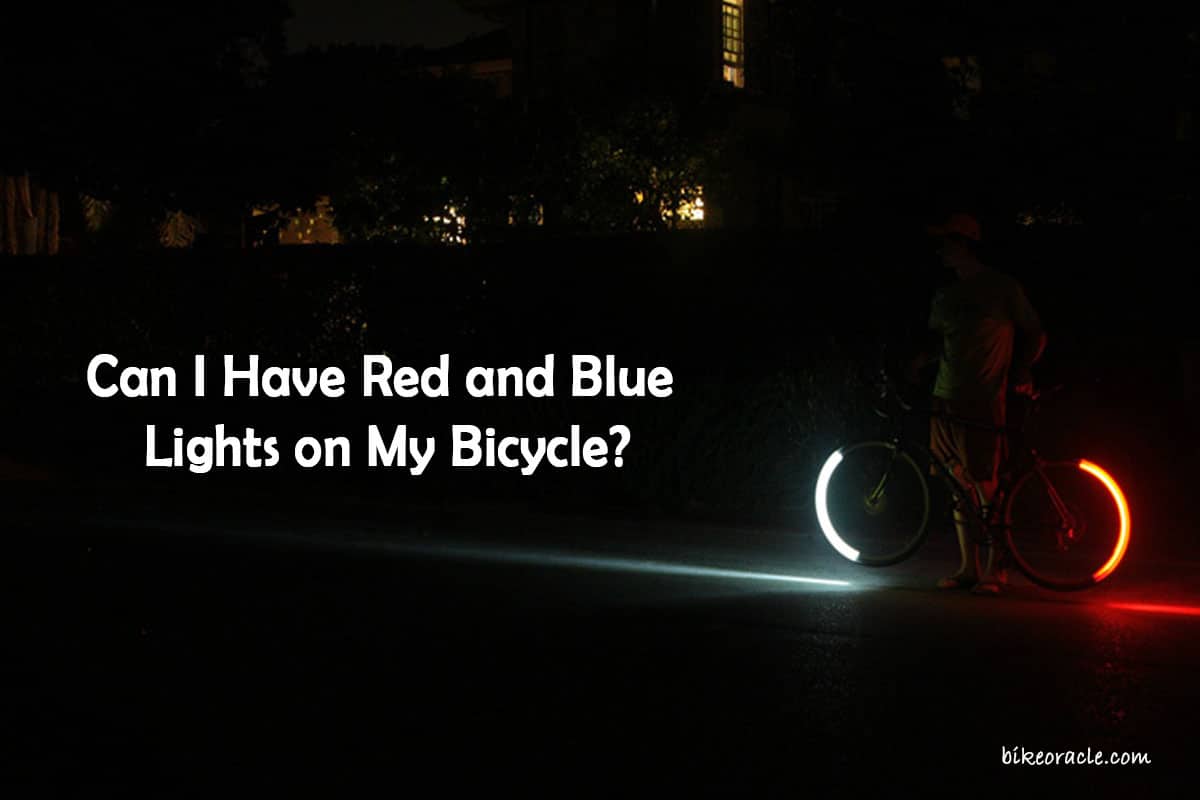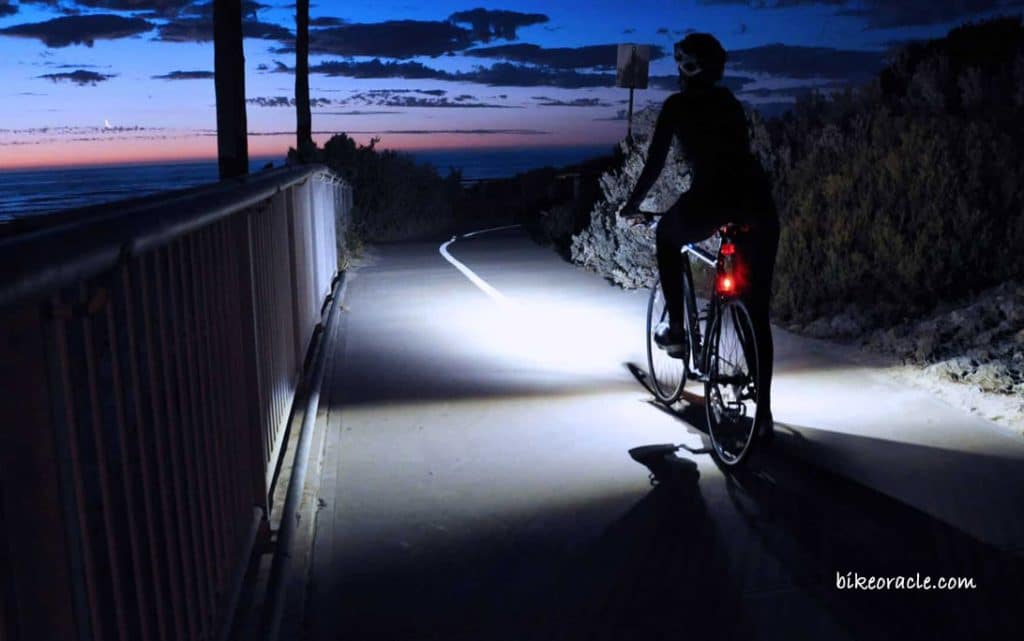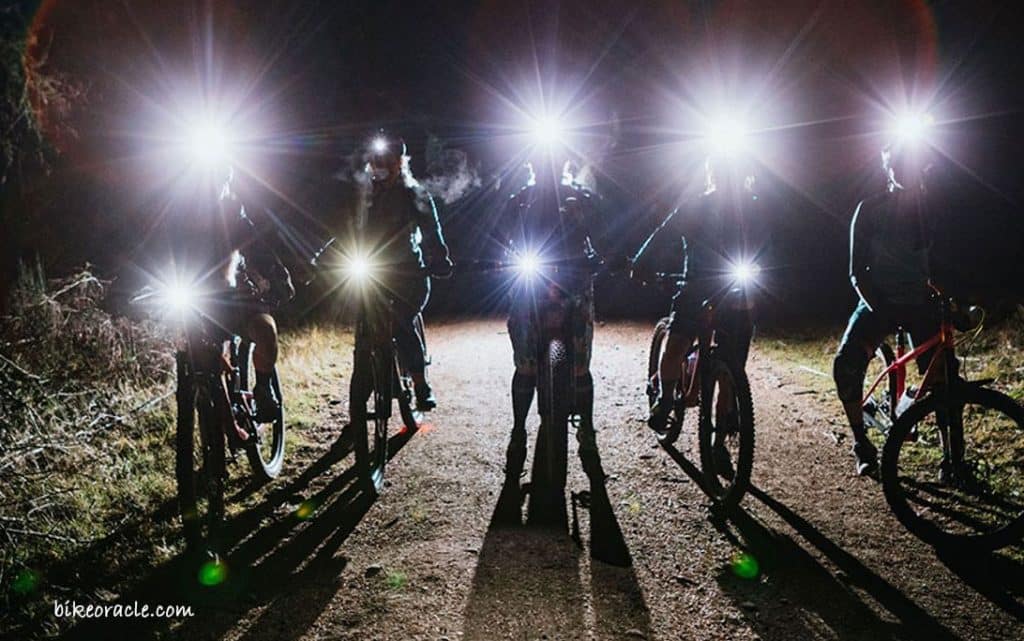Can I Have Red and Blue Lights on My Bicycle? – [Answered]

Cyclists have been enamored by the allure of embellishing their trusty bicycles with a mesmerizing array of radiant lights. These luminous additions not only amplify the bike’s visual appeal but also create a captivating spectacle that enchants both riders and onlookers during nocturnal escapades. With a myriad of colors to choose from, cyclists embrace these dazzling lights as a means of self-expression that sets them apart from the cycling crowd.
However, it is of utmost importance to delve into the legal and safety dimensions surrounding the use of colored lights on bicycles. Undoubtedly, illuminating your bike with lights enhances visibility and bolsters safety measures. Yet, one must tread carefully, heeding the regulations established by local authorities to ensure a lawful and secure cycling journey.
Disregarding these guidelines not only exposes one to potential fines and penalties but also jeopardizes the safety of oneself and fellow road users. Consequently, an important question arises: Can I Have Red and Blue Lights on My Bicycle? Let’s embark on an illuminating exploration of the enigma surrounding red and blue lights on bicycles, placing emphasis on their usage, legality, and safety implications!
Understanding Bicycle Lighting Regulations – The Basics
Until now, we have come across various rules and regulations concerning the proper use of bicycle lighting. These regulations serve as the guiding light to keep cyclists and other road users safe. Ignoring these crucial laws can lead to unwanted consequences, including fines and penalties. It’s essential to shed some light on the importance of abiding by these regulations for a harmonious and secure riding experience.
Lights required during low-light conditions
In low-light conditions, such as night or twilight, cyclists must comply with regulations and ensure their bicycles are equipped with proper lighting. This requirement aims to improve visibility and alert other road users to the presence of cyclists.
Visibility requirements
The lighting regulations often specify the minimum visibility distance required for the lights. This typically includes the brightness, beam pattern, and placement of lights on the bicycle.
Reflectors
In addition to lights, many regulations also mandate the use of reflectors. These reflectors are often placed on the front, rear, sides, and pedals of the bicycle to increase visibility from different angles.
Differentiating between front, rear, and sidelights
Front lights: Front lights, otherwise called headlights, are mounted on the facade of the bike and are pointed forward. They are intended to enlighten the street ahead, permitting the cyclist to see and explore securely in low-light circumstances. Front lights ought to have adequate brilliance and an engaged shaft example to give satisfactory permeability.
Back lights: Backlights, likewise called taillights, are mounted on the back of the bike and face in reverse. Their basic role is to make the cyclist apparent to vehicles coming in from the other side. Backlights ought to produce a splendid, consistent or blazing light to caution drivers of the cyclist’s presence.
Sidelights: Sidelights, likewise alluded to as side marker lights, are discretionary in certain locales yet strongly suggested for added wellbeing. These lights are mounted on the sides of the bike and give perceivability from the side points. They can upgrade the cyclist’s perceivability, particularly during crossing points or while moving toward vehicles from the side.
Importance of complying with local regulations
Complying with local regulations regarding bicycle lighting is essential for several reasons:
Enhanced safety
Proper bicycle lighting increases your visibility to motorists, pedestrians, and other cyclists, reducing the risk of accidents. Sufficient lighting permits you to see the street ahead and any expected snags, working on in general security during low-light circumstances.
Legal Compliance
Complying to nearby guidelines guarantees that you are not infringing upon the law. By getting it and following the particular lighting necessities in your space, you can stay away from likely fines or punishments related with resistance.
Respect for others
Complying with bicycle lighting regulations demonstrates respect for other road users. By making yourself more noticeable, you add to a more secure and more amicable climate for everybody sharing the street.
Make sure to find out more about the particular lighting regulations and guidelines in your locale to guarantee that you meet the necessities and ride securely. Continuously focus on your own security and that of others by utilizing appropriate bike lighting as expected by neighborhood regulations.
The Purpose of Bicycle Lights
Enhancing visibility and safety on the road
Bicycle lights serve the primary purpose of enhancing visibility and ensuring safety on the road. By providing illumination, they help cyclists be seen by motorists and pedestrians, especially during low-light conditions or at night. The lights significantly increase the visibility of the cyclist, reducing the risk of accidents and promoting a safer riding experience.

Signaling intentions to motorists and pedestrians
Bicycle lights also play a crucial role in signaling the intentions of cyclists to motorists and pedestrians. By using appropriate lighting signals, such as front and rear lights, cyclists can indicate their movements, such as turning or changing lanes. These signals help other road users anticipate the cyclist’s actions and contribute to smoother and safer interactions on the road.
Illuminating the path for the cyclist
One more significant purpose behind bike lights is to enlighten the way forward for the cyclist. This is especially helpful in low-light or dull conditions, as well as regions with unfortunate road lighting. By giving a shone light emission, the cyclist can see the street obviously, distinguish hindrances or perils, and explore all the more successfully, subsequently working on generally speaking wellbeing and certainty while riding.
Red Lights for Rear Visibility
Importance of having a red rear light
With regards to cycling security, having a red back light is of most extreme significance. It fills in as an urgent visual sign for drivers and walkers coming in from the other side. By discharging a radiant red light, it improves the perceivability of the cyclist, particularly in low-light circumstances or during evening time riding. The red backlight goes about as an obvious sign of the cyclist’s presence out and about, decreasing the gamble of mishaps brought about by vehicles neglecting to see the cyclist.
Benefits of using red lights for increased visibility
Using red lights on the rear of a bicycle offers several benefits that contribute to enhanced visibility. First and foremost, the red tone is effectively discernable and generally perceived as an advance notice signal, making it more perceptible to other street clients.
Furthermore, red lights have a more extended frequency contrasted with different varieties, permitting them to enter haze, fog, and other unfavorable weather patterns all the more successfully. This expanded perceivability guarantees that the cyclist stays apparent and can be expected by drivers, lessening the probability of crashes.
Recommended specifications for red rear lights
When choosing a red rear light for your bicycle, there are some recommended specifications to consider.
- Look for a light with a high lumen output to maximize brightness.
- A lumen output of at least 50 lumens is recommended for optimal visibility.
- Additionally, select a light that offers multiple lighting modes, including steady and flashing options, to suit different riding conditions and preferences.
- It’s also essential to choose a light with a wide-angle beam to increase the visibility from various viewing angles.
- Finally, consider a light that has a durable and waterproof construction to withstand different weather conditions and ensure long-lasting performance.
White Lights for Front Illumination
Significance of a white front light
A white front light is an essential component of a cyclist’s safety equipment. It fills the essential need of enlightening the rider’s way and making them apparent to vehicles going the opposite way.
By projecting a brilliant, white light emission onto the street ahead, it upgrades the cyclist’s capacity to see expected dangers, like potholes or flotsam and jetsam, and respond as soon as possible. Besides, a white front light builds the cyclist’s perceivability to drivers, making them aware of the presence of a cyclist drawing nearer from the other way.
Providing adequate illumination for the cyclist
The primary function of a white front light is to provide adequate illumination for the cyclist. It ought to offer adequate splendor to enlighten the street ahead and any likely obstructions, guaranteeing a reasonable perspective on the cyclist’s way.

A strong front light with a high lumen yield, like 500 lumens or more, is suggested for ideal brightening, particularly while riding in low-light circumstances or on dim streets.
Additionally, consider a light with adjustable brightness settings to adapt to different riding environments and conserve battery life when maximum brightness is not required.
Recommended specifications for white front lights
When selecting a white front light for your bicycle, certain specifications are worth considering.
- Search for a light with a wide pillar point to give expansive brightening, permitting you to see a more extensive region of the street.
- It’s prudent to pick a light with a battery duration that meets your riding needs, particularly assuming that you as often as possible leave on really long rides.
- Rechargeable lights are a popular choice, offering convenience and sustainability.
- Additionally, opt for a light with a sturdy mounting system that ensures secure attachment to your bicycle, minimizing the risk of accidental detachment while riding over rough terrain.
The Use of Blue Lights on Bicycles
Discussing the appeal of blue lights for cyclists
Blue lights on bicycles have gained popularity due to their unique aesthetic appeal and the attention they attract. Many cyclists choose blue lights as a way to customize their bikes and create a distinct visual style. The vibrant blue glow adds a touch of personality and can make a cyclist stand out from the crowd, enhancing their visibility on the road.
Exploring the legality of blue lights on bicycles
It’s vital to take note that the lawfulness of utilizing blue lights on bikes changes across various purviews. In certain locales, blue lights are limited to crisis vehicles, like squad cars or ambulances.
Hence, it’s pivotal for cyclists to dive more deeply into neighborhood regulations and guidelines with respect to bike lighting to guarantee consistency. In regions where blue lights are allowed, they might be dependent upon explicit limitations, like restrictions on force or glimmering designs.
Always consult local authorities or relevant traffic laws to determine whether the use of blue lights on bicycles is permissible in your area.
Potential safety concerns and risks associated with blue lights
While blue lights may offer a visually striking appearance, there are certain safety concerns and risks associated with their use on bicycles. The use of blue lights may cause confusion or distraction for other road users, particularly if they are commonly associated with emergency vehicles.
Motorists or pedestrians might mistake a cyclist with blue lights for an official vehicle, leading to misunderstandings and potentially hazardous situations. Moreover, the intense brightness of some blue lights can be blinding to oncoming traffic, compromising the safety of both the cyclist and other road users. Therefore, it is essential to exercise caution and consider the potential impact of blue lights on overall road safety before incorporating them into your bicycle lighting setup.
Understanding Emergency Vehicle Lighting Laws
Differentiating between bicycles and emergency vehicles
When it comes to distinguishing between bicycles and emergency vehicles, there are clear distinctions in their lighting requirements and regulations. While emergency vehicles are authorized to use specific colored lights to signal their status, bicycles are typically not permitted to display such lights. It’s crucial to understand the differences to ensure compliance with the law and maintain safety on the road.
Laws surrounding the use of red and blue lights on emergency vehicles
The utilization of red and blue lights on crisis vehicles is exceptionally managed to forestall disarray and guarantee the security of both crisis faculty and the overall population. In many purviews, red lights are held for the back of crisis vehicles, while blue lights are utilized on the front. These varieties have become generally perceived as signs of crisis vehicles, permitting different drivers to recognize them rapidly and answer in like manner.
Emergency vehicles, like squad cars, ambulances, and fire engines, are regularly the main vehicles approved to utilize red and blue lights. The particular guidelines might shift by purview, however by and large, crisis faculty are permitted to actuate these lights while answering a crisis or when participating in true obligations. The utilization of alarms or other perceptible admonition gadgets frequently goes with the enactment of these lights to additional ready drivers and people on foot.
Impact of impersonating emergency vehicles with colored lights on bicycles
Imitating emergency vehicles subverts the power and respectability of policing, clinical benefits, and other crisis responders. It might likewise bring about criminal allegations and extreme punishments, as it is viewed as a serious offense in numerous purviews. To guarantee the security of all street clients and maintain the law, regarding the assigned utilization of hued lights on crisis vehicles is significant.
Impersonating emergency vehicles undermines the authority and integrity of law enforcement, emergency medical services, and other emergency responders. It may also result in criminal charges and severe penalties, as it is considered a serious offense in many jurisdictions.
To ensure the safety of all road users and uphold the law, it is important to respect the designated use of colored lights on emergency vehicles. Bicycles should adhere to the appropriate lighting regulations specified for them, which typically involve using white lights on the front and red lights on the rear. By doing so, everyone can play their part in maintaining order and safety on the roads.
Safety Considerations and Best Practices
Importance of following safety guidelines:
To ensure a safe riding experience, it is crucial to adhere to safety guidelines. Always wear a properly fitted helmet, follow traffic rules, and be mindful of pedestrians. Additionally, familiarize yourself with local e-bike regulations to avoid any legal complications.
Ensuring proper installation and positioning of lights:
Proper installation and positioning of lights on your e-bike play a vital role in enhancing visibility and safety. Position the front light at a height that allows it to illuminate the road ahead effectively. The rear light should be securely mounted and positioned to make you visible to vehicles approaching from behind.
Recommendations for choosing high-quality and reliable lights:
When selecting lights for your e-bike, prioritize high-quality and reliable options. Look for lights that meet safety standards and offer features like bright illumination, long battery life, and durable construction. Reading customer reviews and seeking recommendations can help you make an informed decision.
Alternatives to Red and Blue Lights
Exploring other color options for bicycle lights:
With regards to bike lights, there are different variety choices accessible past the conventional red and blue. Consider dynamic tints like green, yellow, or white, which can likewise upgrade perceivability and add a hint of personalization to your bicycle.
Legal alternatives for enhancing visibility and personalization:
While red and blue lights are typically reserved for emergency vehicles, there are legal alternatives to enhance visibility and personalize your bike. Opt for bright white front lights, amber side lights, or rear lights in colors like red or orange, which are widely accepted for bicycle use.
Creative ways to customize your bike lights within the law:
Customizing your bike lights can be fun and stylish while staying within the legal boundaries. Try using colorful light covers or attachments, reflective stickers, or even programmable LED lights that allow you to create unique patterns. Just ensure that the modifications don’t violate any regulations in your area.
Popular Myths and Misconceptions
Addressing common misconceptions about colored lights on bicycles:
- Myth: Colored lights on bicycles are purely for decorative purposes.
- Fact: While colored lights can add flair to your bike, they also serve important safety functions, such as increasing visibility to motorists and pedestrians.
- Myth: Colored lights are less effective than white lights for visibility.
- Fact: Colored lights can be just as effective as white lights, as long as they meet the required brightness standards and are used in accordance with local regulations.
Debunking myths surrounding the legality of specific light colors:
- Myth: Only white lights are legal for front-mounted bike lights.
- Fact: In many jurisdictions, white lights are indeed required for the front, but some regions permit other colors as long as they meet specific brightness and visibility standards.
- Myth: Red lights are prohibited for use as rear lights on bicycles.
- Fact: While red lights are commonly used as rear lights, it’s essential to comply with local regulations regarding brightness, visibility, and any additional requirements.
Educating readers with accurate information:
- Myth: Different light colors have specific meanings or signals for cyclists.
- Fact: Generally, there are no universally recognized meanings associated with specific light colors on bicycles. Lights primarily serve as a means of visibility and safety, regardless of their color.
- Myth: Colored lights on bicycles can confuse motorists or pedestrians.
- Fact: As long as the lights comply with local regulations and are used appropriately, they can enhance visibility without causing confusion. It’s important to use lights in a manner that clearly communicates your presence on the road.
Frequently Asked Questions
Are colored lights legal on bicycles?
Yes, colored lights are generally allowed on bicycles, but it’s important to check local regulations for any restrictions or requirements.
Can I use multiple colors of lights on my bike?
Indeed, you can utilize numerous shades of lights on your bike as long as they abuse no neighborhood regulations. Nonetheless, it’s prescribed to utilize lights that focus on permeability and security.
Are colored lights more visible than white lights?
Both colored lights and white lights can be visible, but white lights are generally considered to offer better visibility, especially in low-light conditions or when competing with other light sources.
Can I use red lights on the front of my bike?
No, red lights ought not be involved on the facade of your bicycle as they can be mistaken for taillights of different vehicles. Red lights are regularly saved for back confronting lights to show the rear of the bicycle.
Which color of lights is best for visibility during the day?
For daytime perceivability, it’s prescribed to utilize brilliant and differentiating varieties like white, yellow, or green. These varieties contrast the regular environmental factors and make you more apparent to other people.
Are there any specific regulations for using colored lights during night time riding?
Local regulations may vary, but it’s generally advisable to use white lights at the front and red lights at the rear during nighttime riding. This follows the standard practice and ensures better visibility for other road users.
Conclusion
It is crucial to emphasize the importance of legal and safe lighting practices when riding electric bikes. Proper lighting, such as high-luminance headlights, enhances visibility and ensures the safety of both riders and others on the road. By adhering to local regulations regarding lighting, we can reduce the risk of accidents and promote responsible riding habits.
Choose electric bikes with reliable lighting systems and obeying local laws to contribute to a safer and more enjoyable riding experience for everyone. Remember, visibility is key, so let’s ride responsibly and stay safe on the roads.





